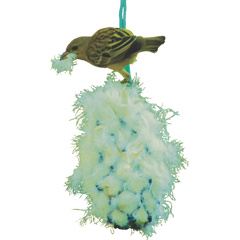What is the importance of a bird’s feathers? It may seem like a simple question, I’m sure the first answer that comes to mind is, “feathers are there so they can fly….DUH,” but there is more than one reason why a birds feathers are very important.
Below are 15 interesting facts about bird’s feathers:
- You guessed it, flying! - Flight feathers are stiff and strong feathers found on a birds wings.
- Warmth - Have you ever seen a bird fluffing its feathers in the cold? Well, it’s not only incredibly cute, birds use downy feathers as well as semiplume feathers to trap air close to the their body’s. Body heat warms the air and the bird warms up, it’s sort of like a blanket. When you see them fluffing themselves they are busy adjusting the amount of heat, by arranging their feathers to trap more or less air.
- Controlling body temperature - To keep body temperature steady, as mentioned previously, birds fluff their feathers, they also expose their heads and feet to the air to cool them down, or tuck them into their feathers to keep them warm.
- Protection – The strong contour feathers shield birds from the wind, these feathers are made from beta-keratin, which is water and wear resistant. The interlocking feather barbs and a special oily or waxy coating helps the water to run off the bird, kind of like a feather umbrella.
- Balancing - When not flying, many birds use their tail feathers as suppor
 t. Tail feathers help them balance on the ground and when climbing on the sides of trees, as seen with the green wood hoopoe. Birds can be acrobats of note! Get yourself a bird feeder and you will see what I mean!
t. Tail feathers help them balance on the ground and when climbing on the sides of trees, as seen with the green wood hoopoe. Birds can be acrobats of note! Get yourself a bird feeder and you will see what I mean! - Feeling - Feathers do not have nerves, but they do stimulate nerves that surround where the feather attaches to the bird. Birds can adjust the position of their feathers and posture depending on the stimulation of those nerves.
- Hearing - Some predators, such as owls, have their face feathers arranged like two dishes (facial discs) to collect and channel sounds into their ears, so they can more accurately locate prey in the dark. (Owls are Ninjas!)
- Making sounds - We think of bird sounds either as songs or calls, but using their feathers, some birds are able to make many different sounds like humming, drumming, and whistling.
- Muffling sounds – Birds that hunt at night, like owls, are able to use their wings to muffle their own sounds as they approach their prey ( Seriously, owls are total ninjas!)
- Pollination – Flowers like strelitzia’s produce lots of nectar to attract birds, like
 sunbirds. The bird’s feathers around their heads pick up the pollen from the flower and transfer it to another flower, it’s pretty much a win/win situation for everybody. Just one of the reasons why we love Elaine’s Nectar and Nectar Feeders is because they help to attract those precious sunbirds to our gardens.
sunbirds. The bird’s feathers around their heads pick up the pollen from the flower and transfer it to another flower, it’s pretty much a win/win situation for everybody. Just one of the reasons why we love Elaine’s Nectar and Nectar Feeders is because they help to attract those precious sunbirds to our gardens. - Eating - Special long feathers called rictal bristles (kind of like bird whiskers) are found around the mouths of some insect-eating birds. These act like a funnel to catch the insect in the air, and they protect the eyes while catching the insect. Other birds use feathers on the side of their mouths to select fruits.
- Constructing nests - Many birds lines their nests with bird feathers. This helps to
 keep their eggs warm and also provides a soft padding. Elaine’s Birding has kind of given the birds
keep their eggs warm and also provides a soft padding. Elaine’s Birding has kind of given the birds  a “helping hand” by providing the Nesting Bag, which is packed with clean soft feathers for their nests.
a “helping hand” by providing the Nesting Bag, which is packed with clean soft feathers for their nests. - Escaping predators - When birds are attacked or frightened they can drop some of their tail feathers, this is called fright molt. Have you ever seen your dog or cat with a mouth full of grey feathers? Well now you know that there is a dove out there that will live to fly another day.
- Sending visual signals - Feather colours and patterns are used to send signals to mates and rivals. Birds like Red Bishops change colours during breeding season, they get their “groove on” to attract females.
- Camouflage - Sometimes bright colours are not good. To keep from being seen by predators, many birds have feathers that blend in with their surroundings so that predators cannot see them.
So there you have it! Fifteen Feathery Facts. We hope you enjoyed our blog.
We would love to hear from you, if you have any questions please feel free to comment below or to email us.

 t. Tail feathers help them balance on the ground and when climbing on the sides of trees, as seen with the green wood hoopoe. Birds can be acrobats of note! Get yourself a
t. Tail feathers help them balance on the ground and when climbing on the sides of trees, as seen with the green wood hoopoe. Birds can be acrobats of note! Get yourself a  sunbirds. The bird’s feathers around their heads pick up the pollen from the flower and transfer it to another flower, it’s pretty much a win/win situation for everybody. Just one of the reasons why we love Elaine’s Nectar and
sunbirds. The bird’s feathers around their heads pick up the pollen from the flower and transfer it to another flower, it’s pretty much a win/win situation for everybody. Just one of the reasons why we love Elaine’s Nectar and keep their eggs warm and also provides a soft padding. Elaine’s Birding has kind of given the birds
keep their eggs warm and also provides a soft padding. Elaine’s Birding has kind of given the birds  a “helping hand” by providing the
a “helping hand” by providing the